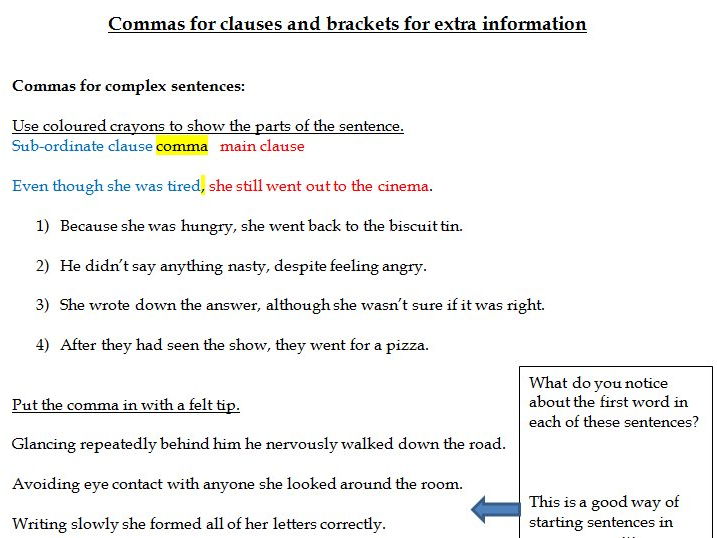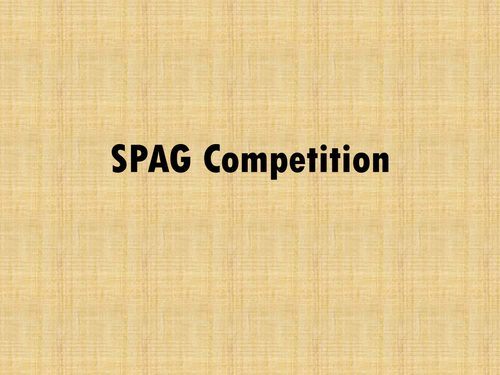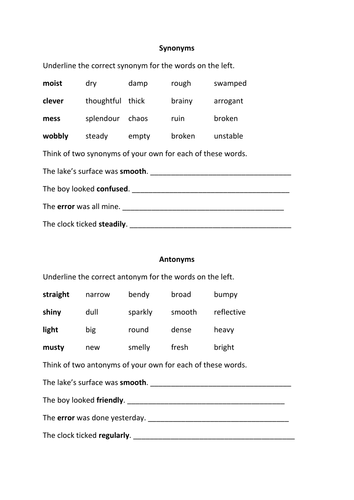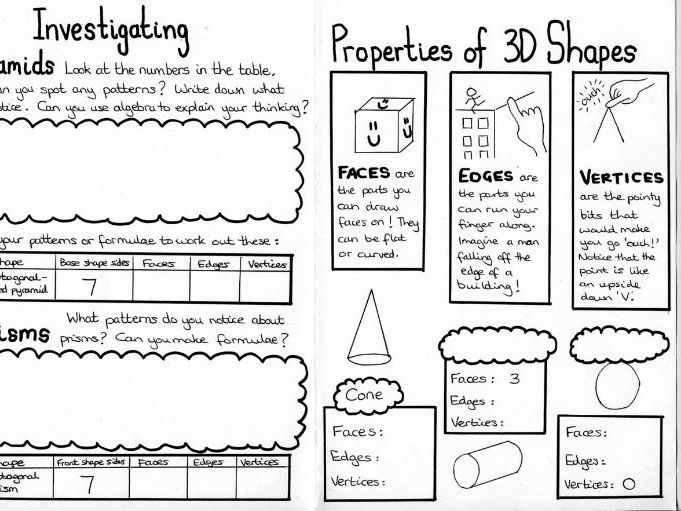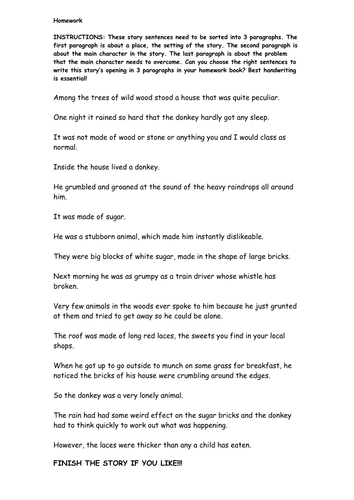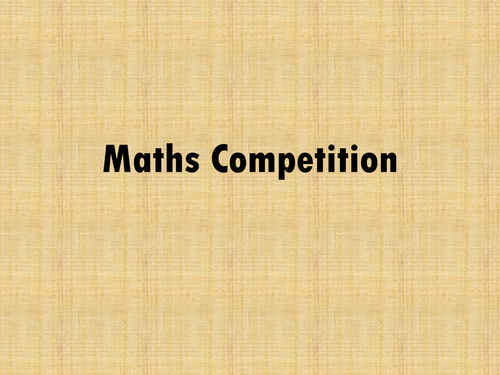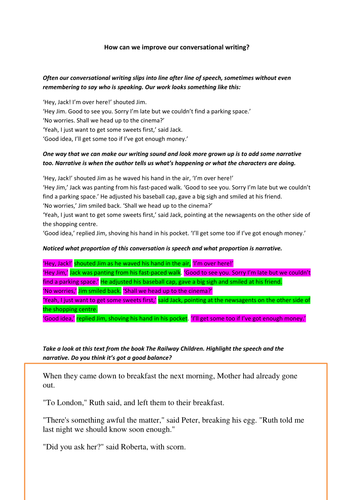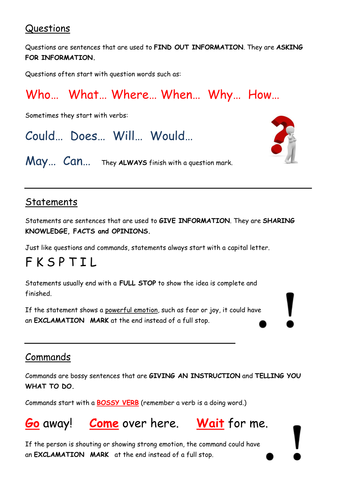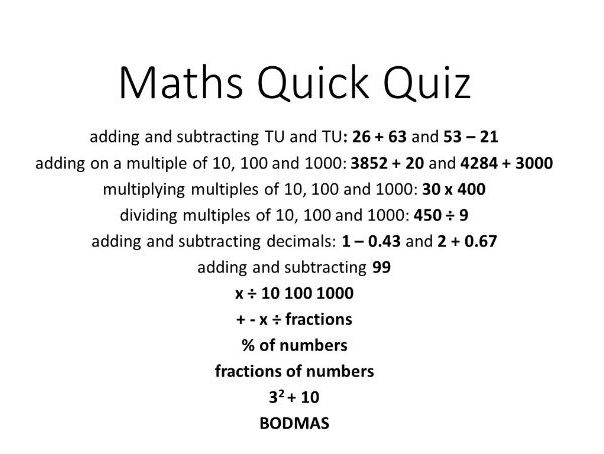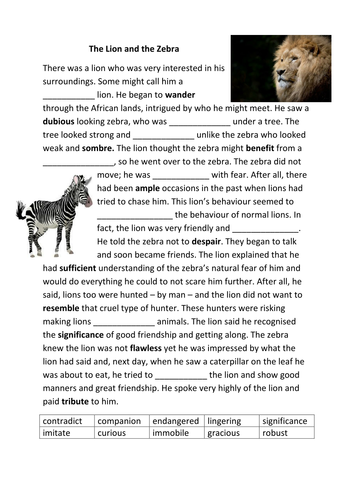46Uploads
37k+Views
15k+Downloads
All resources

The importance and use of direct and indirect speech (reported speech)
This is not simply an activity of changing one to the other. The focus here is about how to make your writing more mature. The first two thirds of the worksheet are an explanation of how indirect speech can be used to avoid the narrator relaying every part of a conversation. It warns against long, tedious and even boring conversations, showing how indirect speech can speed up the narrative to keep the reader interested and the author in control.
The last third of the sheet shows a conversation using direct speech and here the pupils should be challenged to seek out the more important and less important parts in order to turn some of the conversation into indirect speech.

Commas for clauses worksheets (subordinate, embedded, relative, brackets)
This resource comprises two differentiated two-sided worksheets. The first looks at identifying main and subordinate clauses, using ~ing words at the start of a subordinate clause, extending sentences with 'which', inserting brackets around clauses as a way of introducing embedded clauses. It also sees whether they can spot/identify relative clauses and relative pronouns.
The second (higher) double-sided worksheet looks at writing sentences with subordinate clauses (using conjunctions, ~ing words and 'which'). On the second side, it gives examples of embedded relative clauses and then asks the pupil to complete more sentences that have already been started.
I used this for homework and revision after the Y5/Y6 pupils had already been taught the main concepts and sentence constructions.

SPAG competition quiz for KS2 Year 6 SATs revision
This quiz is ideal for two teams of between 4 and 8 but could probably be played with larger groups. It has four rounds including a buzzer round and speed round. There are questions that require team work and some that rely on every member of the team individually. Topics focus mainly on word classes, tenses, punctuation, synonyms and antonyms, clauses, phrases and pronouns.
Enjoy!

Identifying different phrases (noun phrases, adverbial phrases and prepositional phrases)
The one side of the sheet explains that phrases are unlike clauses in that they have no verbs. It then explains what the three different types of phrases are and gives examples of each.
On the second side of the sheet, there are twelve examples of phases that need to be coloured/highlighted/underlined to show which type of phrase they are. Then there are two sentences that involve all three types of phrases and these too need breaking down into the different phrases.

The Midnight Gang - questions, discussions and activities by chapter
As I read through The Midnight Gang by David Walliams, I jotted down ideas of questions and activities to do with my pupils. Organised by chapter, this powerpoint has over 50 slides with questions that cover all aspects of reading comprehension. Some have short, instant answers and others could be expanded into a 20 minute class discussion. For the creative teacher, there are many ideas and questions that could easily be developed into something exciting and memorable for the children. Some activities have been indicated as potentially cross-curricular, including opportunities for art, geography, science, drama and debate.
My purpose in adding this to TES is to provide teachers with a resource they could use in class with little or no preparation. Other teachers may not want to use it directly with the children but use it as a planning aid for their own lessons.

Synonyms and Antonyms
There are four activities here.
1) Circle the word that is the antonym of the main word given.
2) Circle the word that is the synonym of the main word given.
3) Colour the words that are the antonyms and synonyms of the main words given.
4) Improve sentences by choosing a stronger synonym to replace weaker vocabulary.

Word class sorting activity
Lists of nouns, verbs, adjectives and adverbs to be sorted into the correct boxes in a table. Use one column of words each time for a SPAG starter activity.

Properties of 3D shapes investigation - pyramids and prisms
This four page booklet begins with an explanation of the terms ‘edges’, ‘faces’ and ‘vertices’ and then tests this knowledge using three basic 3D shapes. The inside of the booklet has two tables and images of prisms and pyramids. It requires the pupil to find the number of edges, faces and vertices for ten of these shapes. It also asks them for the number of sides of the base shape on the pyramid and the number of sides of the cross-sectional shape on the prism. This is to help with the investigation on the final page. The last page asks pupils to look at the numbers in the tables and spot patterns/rules. It encourages them to express their thoughts in algebra if possible. Then, to test their theories, there are another two shapes to work with on this final page.
Aimed at Year 6 - Year 9 pupils.

Alan Peat 2a sentences (adjectives, commas for lists)
A lesson to introduce Alan Peat's 2a sentences, presented in a word document so that it can be edited for your needs as required. Pages 1,2,4 can be presented on the IWB screen to the children. These involve the introduction, individual/partner activity using whiteboards and the instructions for the plenary activity (which involves editing and improving a previous piece of the child's English work with this new skill). Page 3 needs to be printed as the worksheet for the main activity (finding 2a sentences in a short story and then writing some of their own 2a sentences with prompts for ideas).

Year 6 SPAG Quiz Competition for KS2 SATs Revision
This quiz is made up of 5 rounds with ten slides of questions per round plus a bonus question (usually a harder challenge). Answers are provided so that the quiz could be left for a supply teacher/covering TA.
Play with the whole class working independently, or in teams (it is set up to be played by 2 teams which are indicated by shapes in top corner of each slide). Each slide also has colour coding for level of difficulty and an option for winning points on each question.
Each round has a particular theme or topic: tenses, phrases and clauses, punctuation, types of words and making words (including root words, suffixes and antonyms).

Paragraphs for upper KS2
There are two activities here, one more tricky than the other.
The first gives about 15 different sentences which all form the opening of a story. The sentences need to be sorted into three paragraphs about setting, character and problem. Even within the paragraphs, they need sorting into a logical order. They are designed in such a way that you could cut them up and move them around until you're happy.
The second activity is a short story that is written as one big chunk of text. This requires the children to mark where the new paragraphs should start. About 5 paragraphs are needed.

Apostrophes for possession / belonging / possessive
Here we have all of the resources for a lesson on possessive apostrophes that assumes some children will know the basics already. It would be good for the first lesson *you* have taught them on it, assuming they have done it sometime last year, or as a revision lesson after a long break.
It starts with the whole class reading an article and spotting missing apostrophes before focusing in on some whiteboard work using pictures as prompts. A partner work/table group game (which could be made competitive or even silly/funny if you like!) is then followed by some written activities to go in the book. Plenary and homework provided too!

Maths competition quiz for KS2 Year 6 SATs revison
This quiz is ideal for two teams of between 4 and 8 but could probably be played with larger groups. It has four rounds including a buzzer round and speed round. There are questions that require team work and some that rely on every member of the team individually. Questions focus mainly on topics that come on the arithmetic paper but also on volume, area and angles.
Enjoy!
Edit: The first version I put online had a couple of simple errors which have now been corrected for future downloads. Apologies to anyone who was using it before I noticed the problem.
Also, I have noticed that it might be worth the teacher printing out the slides if you want the answers before revealing them on the projector (e.g. in the rounds where teams can steal points from each other).

The balance of speech and narrative in conversations
This resource seeks to highlight the fact that many children rely too heavily on speech when they are writing conversations. It gives an example of a speech relay (to-ing and fro-ing with speech line after line), which children so often fall into the trap of writing. It then shows how adding some narrative and description in amongst the speech can help the reader picture what's going on better. With two examples of classic children's novels, the children are encouraged to assess the balance of speech and narrative for themselves. Finally the children are given a speech relay which they are asked to 'flesh out' with some narrative to make a good balance for a more mature piece of writing.

Number bonds to 100
Four sheets are provided here: two classwork sheets and two homework sheets with a set for more able and a set for less able.
The sheets look first at making 100 using deines cubes, where children are encouraged to draw the extra cubes and sticks until they reach 100. The second half builds on this, making the link with the deines equipment that the cubes will always make a ten and the sticks will need to add up to the other ninety.
The homework sheets provide more practice of what has been covered in lesson.

Sentence types: Statements, Commands, Questions and Exclamations
This double-sided sheet introduces these four sentence types, explaining what they are are what punctuation they need. It looks at statements, commands and questions first before checking understanding with a simple quick identification exercise. It then looks at exclamations (as these are a little harder to explain) and gives another 5 sentences for children to identify whether they are statements or exclamations.

Maths SATs Year 6 KS2 Arithmetic Revision Quiz
Use this with a small group or a whole class to revise some of the basic skills on the KS2 SATs Maths Paper 1: Arithmetic.
It is designed to be a quiz quick that more able pupils should be able to do in their heads and less able pupils should be able to do in a reasonable amount of time on a whiteboard. The questions are in a fairly random order, although I have often made 3 or 4 consecutive questions follow the same topic so the children get a chance to practise and get into a topic before the next topic comes along. I have also subtly colour-coded the questions so the teacher can instantly see the level of difficulty: 3 shades of blue, with the lightest representing easier questions and the darker shade representing the hardest questions. (This shading is just a rough idea - you may disagree with paritcular questions and want to change the shade! Also note that the shading is relative within the topic: the hardest of the x1000 questions is still much easier than finding 87% of a number!)
This resource could be used so flexibly as a gap-filler e.g. when you’ve got a spare few minutes at the end of the day or before assembly, as a lesson where you can try questions and then discuss mental methods across the class, or as a competitive quiz with teams or individuals, buzzer rounds and speed rounds. It can be saved for year after year too!
There are approx 200 questions covering the following topics:
adding and subtracting TU and TU: 26 + 63 and 53 – 21
adding on a multiple of 10, 100 and 1000: 3852 + 20 and 4284 + 3000
multiplying multiples of 10, 100 and 1000: 30 x 400
dividing multiples of 10, 100 and 1000: 450 ÷ 9
adding and subtracting decimals: 1 – 0.43 and 2 + 0.67
adding and subtracting 99
x ÷ 10 100 1000
x ÷ fractions
% of numbers
fractions of numbers
32 + 10
BODMAS
Answers included on a separate powerpoint. I have checked them but please let me know if you find any errors so I can amend immediately.

Improve vocabulary (word meanings and dictionary work)
This resource shows a story (with a moral a bit like a fable) which has ten words highlighted within the story. These could be used as the initial focus for vocabulary for the lesson. There are also ten blank lines in the story and ten words at the bottom of the page. Children need to insert the words in the correct places in the story. With dictionary work, this could take a whole lesson or be good for a homework activity.
The twenty words are: contradict companion endangered lingering significance imitate curious immobile gracious robust wander dubious sombre benefit ample despair sufficient resemble significance flawless tribute.

Introducing and explaining column addition and its place value
This resource is designed for groups who are in the early stages of column addition. It is used a bit like a smartboard (although it's in word) as its examples need to be worked through with the children. Visually, the questions are shown with arrow cards to help show that adding 2 and 6 in the tens column is the same as adding 20 and 60. This also helps if you are then able to provide this resource children to use 'hands on' in the lesson. For questions that require carrying, the appropriate 10 or 100 is available at the bottom of the page to drag up in to the questions. The first questions are TU + TU with no carrying, reaching HTU + HTU with carrying by the end.


